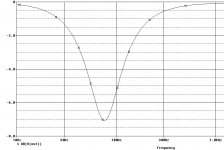Graham Maynard said:No; but I would like to; only you have to pay, and I won't.
I don't like that aspect.
I give all my designs/findings away freely, and yet the AES membership charges. Different ethos.
Cheers ......... Graham.
They're an organization that has expenses to cover. It has nothing to do with ethos. I would also bet that they are are non-profit organization as well and have a small full-time staff that don't want just to give away their time. They're not small-time DIYers.
Dave
Hi,
Two years later, i went through the full 27 pages of this thread. These are my "conclusions":
- Current drive eliminates the "thermal compression" effect.
- Real life drivers do not have constant impedance, and current drive eliminates this being a concern.
- On LF drivers, current drive leaves the driver's mechanical resonance undamped.
- Said mechanical resonance can be corrected via:
(a) Mechanical damping (foam over the woofer surround, etc)
(b) Motional feedback
(c) Equalization
From all this i can see current drive would more advantageously used for tweeters, which (i guess) are more affected by thermal compression.
For mechanical resonances, i see both (a), (b), and (c) alternatives totally valid.
(a) Would be implemented by trial-and-error, the drawback being maybe lower efficiency
(b) Motional feedback is relatively complex to realize but works very well, as we can see in one of the AES papers cited, and as we can see by listening to the many people raving about those Philips MFB speakers.
(c) I wonder how good could equalization work for these resonances... Wouldn't a strong notch filter be sufficient to deal with the driver's resonance?
Or at least we could filter out the resonance frequency and use another, lower frequency driver for the frequencies below...
By the way, i'm assuming a system of 2 or 3 ways, with active crossovers (passive crossovers should not exist in the 21st century!!).
Two years later, i went through the full 27 pages of this thread. These are my "conclusions":
- Current drive eliminates the "thermal compression" effect.
- Real life drivers do not have constant impedance, and current drive eliminates this being a concern.
- On LF drivers, current drive leaves the driver's mechanical resonance undamped.
- Said mechanical resonance can be corrected via:
(a) Mechanical damping (foam over the woofer surround, etc)
(b) Motional feedback
(c) Equalization
From all this i can see current drive would more advantageously used for tweeters, which (i guess) are more affected by thermal compression.
For mechanical resonances, i see both (a), (b), and (c) alternatives totally valid.
(a) Would be implemented by trial-and-error, the drawback being maybe lower efficiency
(b) Motional feedback is relatively complex to realize but works very well, as we can see in one of the AES papers cited, and as we can see by listening to the many people raving about those Philips MFB speakers.
(c) I wonder how good could equalization work for these resonances... Wouldn't a strong notch filter be sufficient to deal with the driver's resonance?
Or at least we could filter out the resonance frequency and use another, lower frequency driver for the frequencies below...
By the way, i'm assuming a system of 2 or 3 ways, with active crossovers (passive crossovers should not exist in the 21st century!!).
Equalization
I have tried to simulate a series resonance circuit (realised with a "synthetic" inductor), see the schematic. Here you have the posibillity to choose the resonance frequency and the Q value as well. I think this is a cheap and easy way to realize the equalization, as long as you know your design parameters.
I wonder how good could equalization work for these resonances... Wouldn't a strong notch filter be sufficient to deal with the driver's resonance?
Or at least we could filter out the resonance frequency and use another, lower frequency driver for the frequencies below...
By the way, i'm assuming a system of 2 or 3 ways, with active crossovers (passive crossovers should not exist in the 21st century!!).
I have tried to simulate a series resonance circuit (realised with a "synthetic" inductor), see the schematic. Here you have the posibillity to choose the resonance frequency and the Q value as well. I think this is a cheap and easy way to realize the equalization, as long as you know your design parameters.
Attachments
I did not understand what you are looking for and what you want to do so what I am telling you could be completely wrong.Mmm... if we can find a low-density magnetically-permeable alloy to make the former out of...
I checked www.matweb.com for materials with density <= 4g/cc, and a magnetic permeability of >= 1000. No luck.
Are you looking for a middle ground between a permanent magnet and a ferromagnetic material? .
if this is what you are looking for then they exist, they are called soft-magnetic materials. very high permeability.
http://magnetism.eu/esm/2021/slides/slides-lupu-1.pdfhttps://www.electrical4u.com/soft-magnetic-materials/
As much as any other... there's no substantial difference between field coil and conventional permanent magnet loudspeakers.
Hmm, the FC's ability to adjust its effective motor strength and more importantly doesn't suffer from thermal power distortion are pretty significant IME.
Why should FC's not suffer from thermal power distortion? That's caused by heating of the voice coil... 🤔
- Home
- Loudspeakers
- Multi-Way
- Current Driven Loudspeakers and Tranconductance Amplifiers
